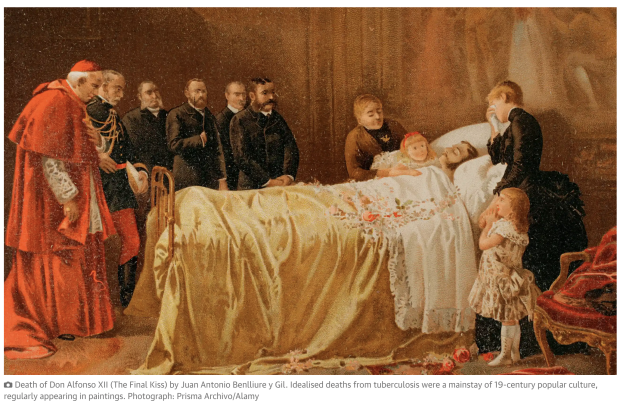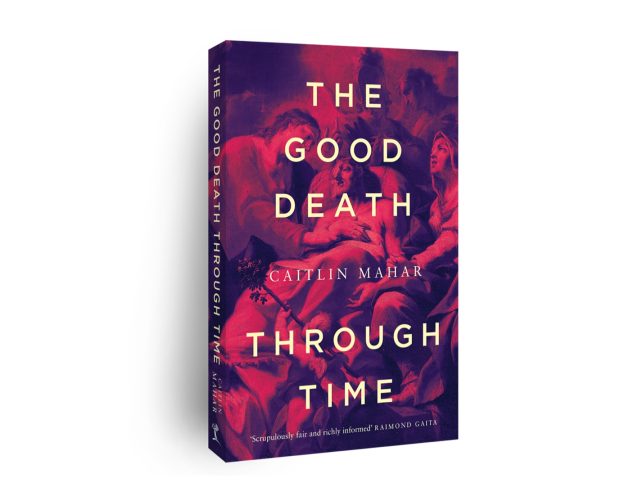February 14, 2023
Pious, prolonged or painless: the remarkable reconception of what it means to die well
Pious, prolonged or painless: the remarkable reconception of what it means to die well – From the ‘blessing’ of consumption to the Euthanasia Machine, the idea of a good death, dying and suffering has undergone a huge transformation in the west …
On a weekday in the 21st century, London’s Science Museum is full of children. In the soaring spaces of the Making of the Modern World exhibition, they flit about artefacts that map our scientific and technological development. A pair of toddlers wobbles towards the wood and wire of Reynold’s 1896 X-ray set, while a whooping snake of primary schoolers follows an exuberant museum educator as he weaves between some of the dark, hulking engines that helped define the 19th century as the machine age.
I move into the dimly lit Wellcome Wing, a gallery devoted to contemporary science. Turning left, I spy the exhibit I have come to see. Tucked unobtrusively in a corner, on a pedestal in a glass cabinet, sits the Euthanasia Machine. A dog-eared packet of the drug Nembutal – traditionally prescribed for “the treatment of animals only” – stands before a small laptop connected to a grey plastic case full of batteries, wires, pressure pumps and a syringe attached to an intravenous tube. A small, scruffy, green and gold sticker on the computer declares this invention is “Australian Made”.
As the sticker suggests, the machine is a long way from home. It was invented by Australia’s “Dr Death”, the physician and prominent euthanasia campaigner Dr Philip Nitschke. Using a software package called ‘The Deliverance Programme’, the computer is designed to inject a lethal dose of drugs through a needle attached to a person’s arm after they answer “yes” to a series of questions on the laptop screen. Between 1996 and 1997, with Nitschke’s aid, four terminally ill people in the Northern Territory used this machine to end their lives under the sanction of the Rights of the Terminally Ill Act 1995 – the first legislation in the world which allowed doctors to actively assist patients to die.
The term euthanasia itself, is a compound of two Greek words – eu and thanatos – denoting “good death”. According to the Macquarie Dictionary, euthanasia is “the deliberate bringing about of the death of a person suffering from an incurable disease or condition, as by administering a lethal drug”. Through the centuries, its meaning has evolved as it has been shaped by, and helped to shape, the broader cultural contexts of death and dying in which it has appeared. In antiquity, euthanasia meant, literally, a good death, but the word was used to describe deaths that differ markedly from those evoked by a 21st-century dictionary definition. For the Greeks, a good death meant a natural one from old age or a death in the lap of luxury: it was a gift the gods bestowed on the virtuous or simply lucky.
Romantic tuberculosis and the rise of the swift death
s Christianity became the dominant lens through which people in western Europe viewed death and dying, the term euthanasia accrued new meaning, changing to signify a pious death blessed by God. This was a good death as illustrated in the popular ars moriendi (art of dying) guides, a literature of instruction developed during the medieval period that continued to be influential well into the 19th century. These manuals circulated in printed books with illustrations, and gave the dying, the clergy and lay helpers a sense of what to expect as death approached, and prescribed prayers, attitudes and actions intended to guide the gravely ill towards salvation.
At the heart of the story of euthanasia is a remarkable reconception of what it means to die well in the west. Today, regardless of which side of the euthanasia debate we line up on, for most of us what we might call a good death is likely to involve dying swiftly and painlessly. But this is a relatively recent conception of what it means to die well. Until at least the middle of the 19th century, most Australians would have considered a swift or sudden death a bad death because it allowed no time for spiritual preparation and repentance.
Can a mass shooter demand a good death? The strange case that tested the limits of justice
This helps explain the Victorians’ (in)famous romanticisation of drawn-out deaths from tuberculosis, But the dying tubercular were also celebrated in sermons, personal accounts and even medical treatises in ways utterly foreign to modern sensibilities. As historian Pat Jalland points out, there were physicians who believed, for example, that contraction of consumption could be a “blessing in disguise” because “it allowed time and mental clarity for spiritual preparation of the soul through suffering”.
Drawing on his experience of hundreds of deathbeds, Dr Samuel Beckett concluded in 1854 that it was in fact far better to die slowly from consumption than in the blur of fever or from a sudden accident. By the end of the 19th century, however, Australians were increasingly looking askance at such sentiments: most people would have seen the sort of lengthy, painful consumptive death idealised by Victorians as epitomising a bad death rather than a good one.

A strange moral transformation
What led to this complete reconfiguration of what it means to die well? The answer to this question is intimately tied to changing deathbed rituals as well as a transformation in cultural understandings of the pain of dying. From the 19th century, doctors started to replace clergy and family at the deathbed and began to treat the dying with painkillers as well as prayers. These new moves to palliate the pain of dying were part of an astonishing revolution in pain relief. From the 1840s, appreciation of the anaesthetic properties of chloroform and ether, as well as innovations such as the hypodermic syringe, made it possible for doctors to manage people’s pain in ways that just a decade before had been inconceivable.
On the cusp of the 20th century, psychologist and philosopher William James observed that a “strange moral transformation” had taken place in less than a century. The introduction of revolutionary new methods of pain relief paralleled a growing cultural antipathy or sensitivity to suffering in the Victorian age. Or, to put it another way, in the 19th century we see the birth of a western response to pain that is familiar to us.
It may be so familiar that it doesn’t strike us as particular or peculiar, and yet, as James Turner argues, it is “uniquely characteristic of the modern era”. “[T]hat dread of pain – that ‘instinctive’ revulsion from the physical suffering even of others” may appear natural and universal, but history tells us that it is particular to our time and place. Turner underlines that we have not always thought and felt pain in the way we do now; like dying, pain and suffering have a history. One clear and consequential product of this history in the west is the emergence in the late 19th century of the euthanasia movement as we know it.
In Australia, Victorian state legislation allows for individuals over 18 who are terminally ill with a life expectancy of less than six months (12 months for those with a neurodegenerative disease), and whose condition is causing suffering they find intolerable, to seek medical aid to die. The default position is that the lethal dose of narcotics be self-administered, but a doctor may administer it if the patient is incapable of doing so themselves. The premier, Daniel Andrews, said the government-sponsored legislation was about “compassion and choice” and hailed it as “the safest, most conservative, in the world”.
However, Victoria’s Voluntary Assisted Dying Act 2017 has come under attack for its conservatism, for, as one critic put it, “a legislative focus on maximising safety that comes at the expense of equal access”. An early point of contention has been section 8 of the act, which requires that the patient, rather than a health professional, introduce the option of a medically assisted death. Designed to avoid even subtle pressure (real or imagined) being placed on a patient to opt for this treatment, critics argue it’s likely to “stigmatise” and restrict access to assisted dying, compromising some patients’ choices and care.
The future for the good death
ince becoming the first physician in the world to legally administer a lethal injection to end a terminally ill patient’s life, Nitschke has changed his views on who should be able to access an assisted death. He now believes that if we are to take notions of personal autonomy and choice seriously, a painless assisted death should not just be available to those people a doctor deems are terminally ill or in unbearable pain, but to any adult of sound mind.
Recently, Nitschke has attempted to more fully realise his vision of a democratised, de-medicalised, painless good death by inventing a new machine. The Sarco, short for sarcophagus, is a sleek, spaceship-like pod designed for one. The idea is that after passing an online mental fitness test, potential users receive a 24-hour access code with which to enter the machine. Once activated from the inside, the Sarco’s capsule compartment fills with liquid nitrogen which rapidly reduces the oxygen levels and, Nitschke assures, results in a swift, painless (even perhaps “euphoric”) death for the occupant.
The Good Death Through Time by Caitlin Mahar. Photograph: MUP
It’s not clear if this new machine will get the legal go-ahead, but some see its very existence as instigating welcome debate about the future of euthanasia that could lead people, including legislators, to look at end-of-life options in new ways. Nitschke’s futuristic suicide pod and the world’s safest, most conservative assisted dying legislation are both legacies of the profound shifts in cultural conceptions of the good death, dying and suffering.
Acknowledging the historical and cultural contingency of contemporary rituals associated with what is considered a good death might illuminate the strengths and weaknesses of the responses to dying and suffering that predominate here and now. It may also, I hope, foster an appreciation of attitudes and responses to dying and suffering that have been, and that are, nurtured in other places and other times, and sharpen critical awareness of those that could be cultivated into the future.
This is an edited extract from The Good Death Through Time by Caitlin Mahar, published 7 February 2023 (MUP)
